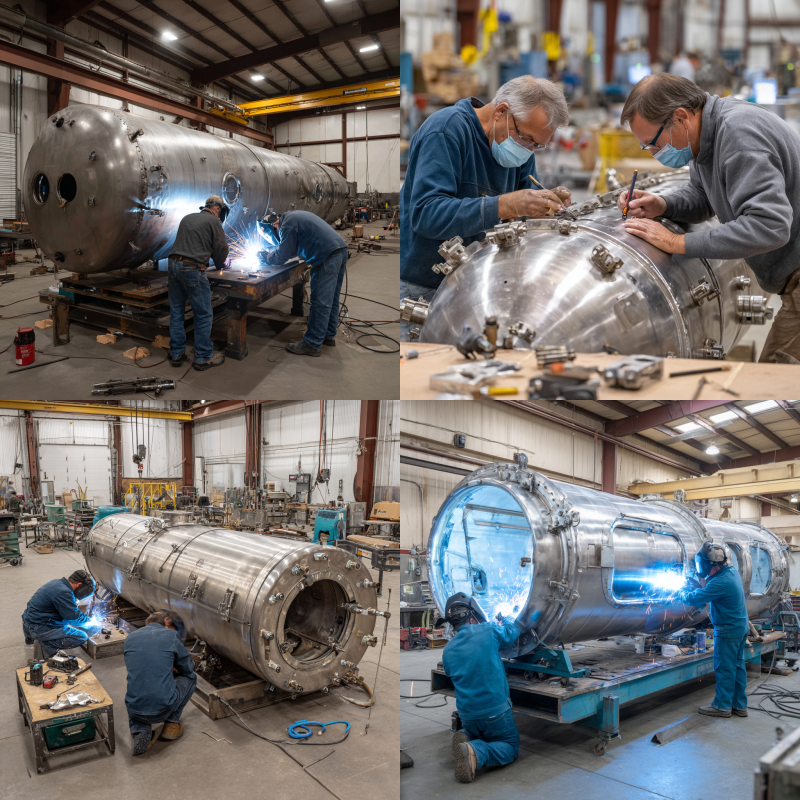
What Is Pressure Vessel Fabrication and Why Does It Matter
Understanding What Is Pressure Vessel Fabrication and Its Importance for Industrial Safety
Pressure vessels are essential for safely containing liquids or gases under pressure, used in a wide range of applications, from energy production to chemical processing. You might ask, “What is pressure vessel fabrication, and why does it matter?” In general terms, it is the process of designing and building these specialized containers so you gain efficiency, safety, and peace of mind across a range of industries. Just as important as the fabrication itself are the pressure vessel safety guidelines outlined by organizations like ASME and OSHA, which mandate strict design, material, and inspection standards to prevent accidents and ensure long-term reliability. Below, we will explore how fabrication works and why choosing a capable manufacturer can save you time, money, and stress.
Explore What is Pressure Vessel Fabrication
Pressure vessel fabrication is the end-to-end creation of custom or standard vessels that withstand internal or external pressure. This delicate process includes material selection, welding, testing, and adherence to codes such as the American Society of Mechanical Engineers (ASME) standards. A well-made vessel can handle demanding conditions without risking leakage or structural failure.
Because these vessels operate under intense pressure, each component must align with rigorous guidelines. Skilled fabricators often use advanced techniques, from detailed 3D models to certified welding processes, to ensure the final product meets or exceeds safety rules. If you are curious about more technical details, you can also check how are pressure vessels fabricated.
Pressure Vessel Fabrication Steps: From Design to ASME Testing.
Fabrication typically unfolds in several stages:
Design and engineering
Engineers outline the vessel’s geometry, pressure rating, and performance needs. They use standards like ASME to ensure each design is safe and efficient.
Material selection
Most pressure vessels use steel, stainless steel, or other alloys. The choice depends on temperature thresholds, corrosion resistance, and required tensile strength. For deeper insights, see what materials are used in pressure vessel fabrication.
Cutting and forming
Sheets or plates of metal are cut to precise dimensions, then shaped (often by rolling) into heads or cylindrical shells. Automated equipment helps maintain consistency.
Welding and assembly
Certified welders join each section, applying processes like TIG (tungsten inert gas) or MIG (metal inert gas) welding. Tight quality control verifies each seam is defect-free.
Inspections and testing
Non-destructive tests (like ultrasonic or radiographic checks) confirm structural integrity. Hydrostatic or pneumatic testing checks the vessel under pressure before the unit ships to your site.
Prefabrication, conducted in a controlled environment, can significantly boost speed and quality. According to Red River, a team experienced in pressure vessel fabrication, working indoors prevents weather delays and reduces the chance of on-site errors.
Discover Why it Matters
A dependable vessel can make or break system efficiency. Here are the key reasons pressure vessel fabrication is so important:
- Safety first: By following strict codes and thorough inspections, you minimize the chance of leaks or ruptures.
- Cost efficiency: Prefabrication saves on labor hours, eliminates weather slowdowns, and lowers shipping costs, so you see fewer unexpected expenses.
- Regulatory compliance: ASME stamps and other certifications show that the finished vessel has passed rigorous standards, which helps you avoid compliance fines.
- Long-term performance: Quality manufacturing leads to fewer repairs or downtime. That means you get consistent output and a higher return on investment.
One leading name in the industry is Red River, an ASME-certified manufacturer that specializes in modular systems and custom designs (Red River). They emphasize advanced welding methods, total material traceability, and prefabrication to keep your project running smoothly.
What Is Pressure Vessel Fabrication
At its core, what is pressure vessel fabrication about? It’s the art of combining precision, safety, and performance to create vessels that stand up to demanding industrial conditions. Whether you’re in power generation, oil and gas, or food processing, a well-fabricated vessel ensures reliable operations and compliance with strict regulations.
Partnering with a trusted expert like Red River—offering ASME-certified pressure vessel fabrication, advanced prefabrication, and complete project support—delivers both peace of mind and operational efficiency.
In today’s competitive industries, pressure vessel fabrication isn’t just about building a vessel it’s about safeguarding people, protecting assets, and driving productivity. With the right fabrication process, you secure compliance while ensuring long-term performance.
Need a Trusted Partner in Pressure Vessel Fabrication?
Don’t leave safety and performance to chance. Whether you need modular skids, custom fabrication, or long-term reliability, Red River delivers solutions that meet code and exceed expectations. Get in touch with an expert to discuss your pressure vessel fabrication needs today.
Frequently Asked Questions
1. What is pressure vessel fabrication?
Pressure vessel fabrication is the process of designing, manufacturing, and assembling containers built to hold gases or liquids at high pressure. It involves strict adherence to safety codes, such as ASME standards, to ensure durability and reliability. The process combines engineering expertise, precision welding, and quality testing to meet industry requirements.
2. How are pressure vessels fabricated?
Pressure vessels are fabricated through a series of steps including material selection, cutting, forming, welding, and assembly. After fabrication, they undergo rigorous inspections and non-destructive testing to verify structural integrity. The final vessel is often coated or treated to enhance corrosion resistance and longevity.
3. What materials are used in pressure vessel fabrication?
Common materials include carbon steel, stainless steel, and alloys like Inconel or Hastelloy, chosen for strength and corrosion resistance. The selection depends on the vessel’s intended pressure, temperature, and stored medium. Advanced composites and clad materials may also be used for specialized applications.
4. What is the difference between a pressure vessel and a regular tank?
A regular tank may store fluids at or near atmospheric pressure. A pressure vessel, however, is built to hold higher internal pressure, requiring thicker walls, specialized welds, and strict adherence to safety codes.
5. Why is ASME certification important?
ASME standards ensure your vessel meets industry-recognized safety and quality criteria. Manufacturers who carry ASME stamps undergo regular audits and must maintain stringent production and testing disciplines.
6. Which industries need pressure vessels most?
You will see pressure vessels in oil and gas, chemical plants, power generation, food processing, and pharmaceutical sectors. Anywhere you have pressurized fluids, you likely need a certified vessel.
7. Can I choose any material for my vessel?
Not all metals are suitable, because each application has different requirements. Stainless steel works well for corrosion resistance, and carbon steel may be more cost-effective for standard duties. Learn more by visiting what materials are used in pressure vessel fabrication.
8. How often should pressure vessels be inspected?
Many guidelines suggest an annual inspection, although certain conditions might require shorter intervals. Checking for signs of corrosion, cracks, or pressure loss helps address small issues before they become safety risks.
Key takeaways
- Pressure vessel fabrication is a specialized procedure for designing containers for pressurized liquids or gases.
- ASME codes safeguard quality, ensuring your vessel is strong enough for high-pressure scenarios.
- Prefabrication in a controlled environment speeds up production and lowers error rates.
- Regular inspections keep vessels functional and extend their lifespan.
- Partnering with an experienced manufacturer improves safety, reduces costs, and maximizes uptime.
